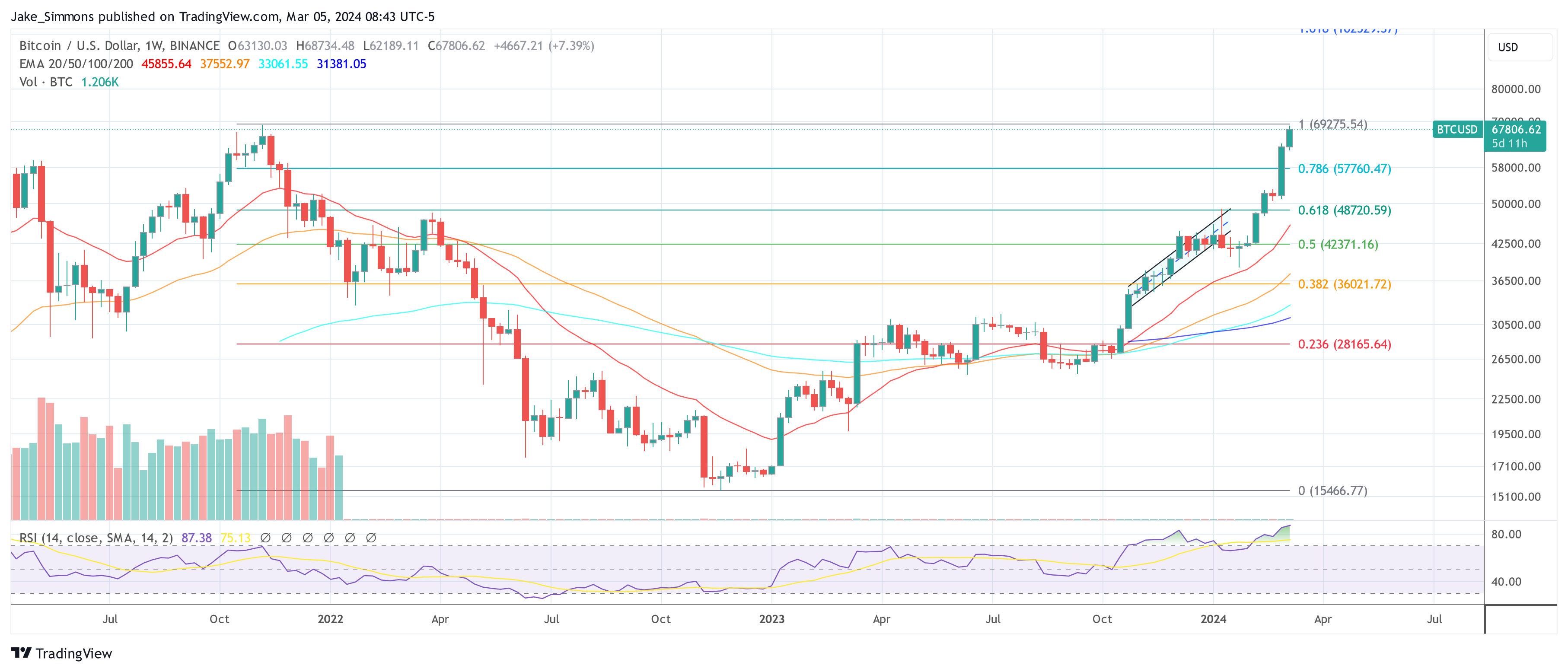In a series of explanations On “I don’t think I’ve ever been more bullish on Bitcoin than I am right now,” he noted, pointing to the cryptocurrency’s recent performance and lack of widespread hype as a prelude to what he calls a “supercycle.”
Understanding the concept of a ‘super cycle’ is crucial to understanding Van der Chijs’ perspective. Unlike regular market cycles that have periodic rises and falls, a super cycle in the Bitcoin domain refers to an extended period of bullish growth over several years. This phase is characterized by a substantial increase in adoption, demand and price, often leading to far-reaching economic consequences.
Essentially, a supercycle marks a paradigm shift in which asset values escalate dramatically, supported by continued inflows of investment and a growing consensus about their long-term viability. To reach this conclusion, Van der Chijs’ prediction depends on various observations and trends within the Bitcoin sector.
Why a Bitcoin Supercycle Could Be Possible
First, he notes a significant shift toward Bitcoin ETFs by funds, including yesterday’s historic announcement of Blackrock’s Strategic Income Opportunities Fund. This move signals robust institutional interest that could fuel a steady flow of investment into Bitcoin, paving the way for a super cycle.
“This will be a constant flow of new money into the ETFs. […] The flows to the ETF are becoming larger, not smaller,” Van der Chijs noted. With financial advisors ready to recommend Bitcoin ETFs to clients after a regulatory settlement period, Van der Chijs sees a flood of new capital on the horizon. This expectation is not unfounded, given the groundbreaking success of the Bitcoin ETF launch, which he calls “the most successful ETF launch ever.”
Business strategies around Bitcoin also play a crucial role in Van der Chijs’ supercycle theory. He points to Microstrategy’s aggressive, leveraged Bitcoin buying as a harbinger of a trend where companies are increasingly viewing Bitcoin not just as an investment, but as a fundamental aspect of their financial strategy. This shift, according to Van der Chijs, could prompt other CEOs to follow suit, further accelerating Bitcoin’s rise.
Furthermore, a critical mass of financial advisors are poised to recommend Bitcoin ETFs to clients, pending the expiration of regulatory and due diligence waiting periods. This opens the gates to substantial new investments from a segment that has traditionally been cautious about direct investments in cryptocurrency. “They cannot sell the ETF for the first 90 working days (internal regulations mainly due to DD), although they are following this quickly for this ETF,” said Van der Chijs.
FOMO and a self-fulfilling prophecy
The speculation surrounding unidentified large-scale Bitcoin acquisitions adds a new layer to the supercycle story. Van der Chijs hints at the intrigue surrounding a wallet that has been steadily accumulating Bitcoin, hinting at the involvement of a billionaire who may be related to Jeff Bezos. “Since November 2023, a wallet has added an average of around 100 BTC per day, the wallet now holds more than 50,000 BTC,” he said, noting the potential of influential figures to catalyze broader market moves.
Another argument is potential purchases by nation states. While nation-state involvement in Bitcoin has been minimal, with El Salvador being a notable example, any increase in such activity could cause a domino effect. Nation-state participation in the Bitcoin market could significantly elevate Bitcoin’s status as a sovereign asset class.
Subsequently, the retail sector remains largely sidelined in the current cycle, but Van der Chijs expects a surge in retail interest following new record highs and increased media coverage. This could initiate a FOMO cycle, attracting more investments from traditional asset classes to Bitcoin.
Finally, Van der Chijs mentions the concept of a self-fulfilling prophecy: while Bitcoin continues to rise without significant dips due to the constant inflow of new money, more people and institutions will cherish the concept of a super cycle. This in turn could lead to greater capital allocation to Bitcoin, making the super cycle more likely.
Macroeconomic implications of a supercycle
Van der Chijs’ theory also addresses the potential macroeconomic implications of a Bitcoin supercycle, predicting a significant shift in wealth and power structures. The redistribution of wealth could put Bitcoin at the center of a new economic order, with traditional asset classes potentially losing ground.
In conclusion, Marc van der Chijs lays out a compelling argument for a coming Bitcoin supercycle, supported by a confluence of institutional, corporate, speculative and retail trends. He acknowledged the speculative nature of his prediction: “Right now I think there’s a maybe 10% chance that this will happen and that chance is increasing (very slowly).”
However, the consequences can be enormous. “[I]It will change the existing world order. It will suck money from the stock and bond markets, from gold and other commodities, and even from real estate (global housing prices could collapse). This will lead to BTC prices that we cannot even imagine today, potentially millions of dollars per BTC.”
At the time of writing, BTC was trading at $67,806.

Featured image created with DALL·E, chart from TradingView.com
Disclaimer: The article is for educational purposes only. It does not represent NewsBTC’s views on buying, selling or holding investments and of course investing involves risks. You are advised to conduct your own research before making any investment decisions. Use the information on this website entirely at your own risk.













